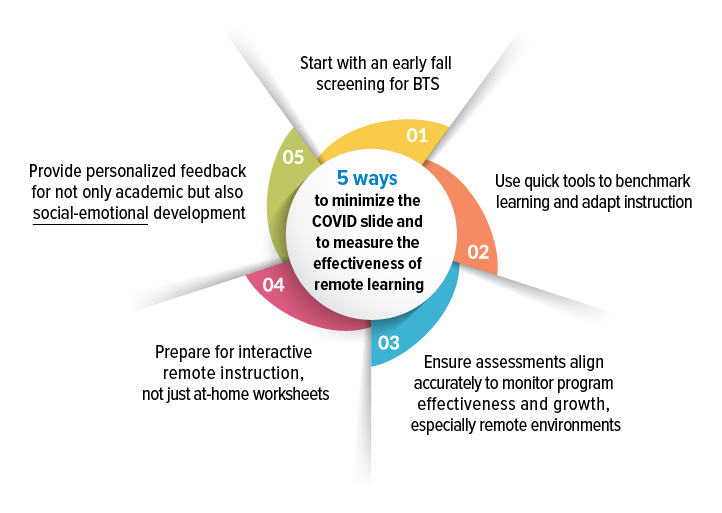
This shift happened overnight for most educators, without warning, without the technology or tools infrastructure, and without the proper training. Thousands if not millions of students across the country still have limited internet or device access or are without technology access entirely. This begs the big question everyone is asking now as we look to the fall: how are we going to close the COVID learning gap? Talk to administrators, teachers, and parents alike, and most would agree that our students are not receiving the same level of education as they were when they were sitting in a classroom with their peers, so how much learning ‘slide’ has COVID-19 caused?
While only time and data will tell, here are 5 ways to understand the impact of COVID on your students' learning and ways to tackle the gaps:
1. Start with an early fall screening for back to school.
As much as we were collectively worried about learning slides during this spring, many educators are starting to turn their attention to the fall as schools are more and more likely to have blended learning or remote learning in place instead of in-person instruction for all students on a daily basis.
School systems must design and implement assessment screening programs to accurately gauge where students landed on the learning continuum. Educators must be prepared to work with students who are not as ready to start the next grade level as they would have been in the past. With standards and pacing guides, start at the beginning of the grade-level year, teachers will need to know how much content was missed and where the learning gaps are from the end of the prior year in order to reinforce or re-teach concepts. With data to gauge master of core concepts, educators have more insights to help ensure students are prepared to tackle the content for the grade level they are currently in. Moving forward with content that students are not ready for will perpetuate the COVID learning gap – not close it.
2. Use quick tools to benchmark learning and adapt instruction.
Building on the fall re-entry, whether learning is in person or remote, educators must employ a variety of tools to gauge the progress of their students. This is done through different types of assessments - from achievement to ability, formative to benchmark, RTI to EL solutions - each tool should be used to provide a comprehensive view of each student’s academic progress or regression and inform how teachers and administrators are modifying programs and instruction to close the gaps.
Finding assessments that offer many different looks at a student allows for more a personalized understanding of learning and supports better decisions for program placement, intervention strategies, curriculum modifications, and resource needs at the classroom, grade, building or district level. Exit tickets, large group discussions, small group discussions, thumbs up / down, and circulation are all ways to monitor student progress.
"[The] big question everyone is asking now as we look to the fall [is] how are we going to close the COVID learning gap?”
Riverside’s portfolio of ability, achievement, EL, and RTI assessments offers teachers a variety of data points to support program and instructional decisions for students over the course of the school year. A fall administration of a quick screening assessment like Iowa Assessments™ Survey Battery paired with the CogAT® Screening Form allows teachers to quickly gauge student ability to place them in the proper programs, plan instructional units based on prior knowledge, and create student groups based on each student’s progress. Administering adaptive benchmarks like IowaFlex™ during the school year gives teachers data on how each student is progressing towards end-of-the-year targets so they can adjust student groups to maximize student learning outputs. Using Iowa Assessments or state tests at the end of the year allows teachers to gauge overall student mastery of academic concepts and begin to support teachers for the following year by supplying data and potential student groupings.
3. Ensure assessments align across grades and schools to accurately monitor program effectiveness and growth, especially in remote environments.
Educational silos have been around for decades. Some educators are notorious for attending professional development and then going back to their schools, closing the door, and doing what they have always done. This can also be true at the school and district level. Now more so than ever, school systems need to employ common assessments to gauge the effectiveness of curriculum and programs across students and grade levels. Educators must be comparing apples to apples, not apples to oranges so that they can discover best practices and replicate actions that are resulting in learning gains. By employing common assessments, schools can continue to monitor the progress of students, create digital data walls, and identify students for interventions.
4. Prepare for interactive remote instruction, not just at-home worksheets.
As schools across the country quickly pivoted to remote learning, most educators were solely focused on being able to get all their students online and logged in. This was a monumental task as tens of thousands of students across the country had limited to no access to devices or hot spots. But due to this rapid shift, many projects, peer work, and collaborative events were put on hold, and students were tasked with completing worksheets and other simple tasks online. These assignments assess lower level thinking on Bloom’s Taxonomy and Webb’s Depth of Knowledge charts.
As many educators consider the potential for ongoing remote learning in the fall, preparing for a more interactive remote instruction model will be key to closing the learning gap. With tools now available to students and teachers, students can and should take advantage of web video features. Students can easily collaborate on projects together almost as easily as they do in-person. Learning to use video collaboration tools provides students with skills to prepare for higher education and a variety of careers that now operate remotely on a regular basis. Documents can seamlessly be shared via G Suite tools for immediate feedback and alterations, as well as reviews by the teachers. By taking advantage of these tools, students will be exercising higher level thinking skills.
5. Provide personalized feedback for not only academic but social-emotional development.
Whether school remains remote or returns to the in-person classroom, it will be more important than ever that teachers check in with their students to see how they are doing. The notion of evaluation and feedback needs to adapt to the learning environment to be as interactive as possible to support students' academic needs, but maybe more importantly, their social emotional development. One of the more effective feedback methods in remote learning can be an audio or video file / attachment delivered through an LMS like Google Classroom or Seesaw. This way, teachers can give the same type of feedback they would if they were in the classroom. Written feedback tends to be truncated, while in-person feedback can be more detailed and targeted. The best way remains giving students one-on-one individualized support, but in a virtual setting, this can be difficult with 30 students at the elementary level, let alone 120 at the middle and high school levels.
John Hattie explores the notion of feedback in his research over the past 30 years. He recommends that feedback be focused on the task, not the learner, and that it be as simple as possible. The point of the simplicity is to ensure that the learner receives the feedback and is able to process it in order to move his or her work forward. This constant feedback will help teachers constantly assess the progress of their students and to be able to put measures in place to close the gap from learning loss during COVID-19.





